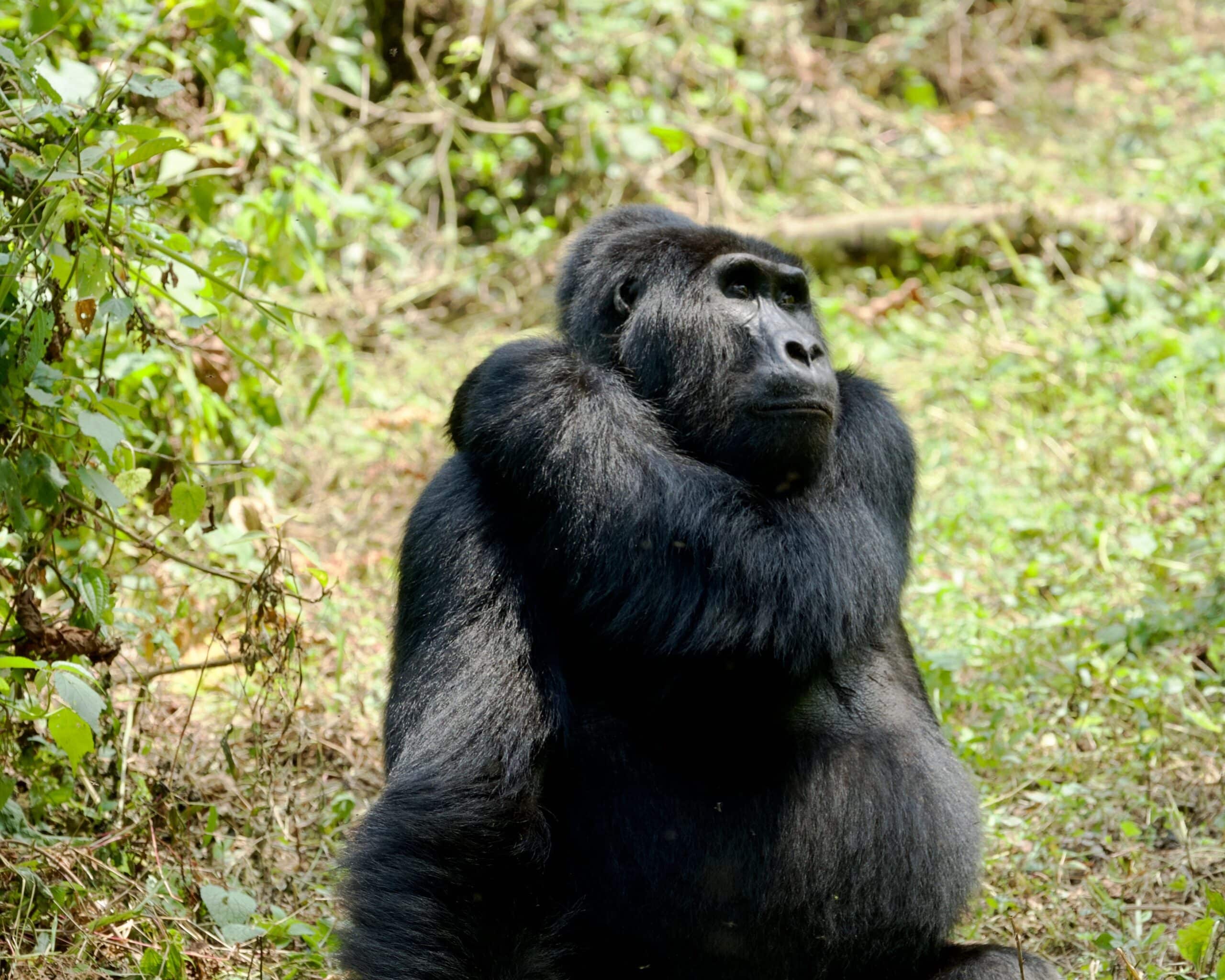
5 things to expect about Mountain gorillas
Posted on August 8, 2022
Do you know mountain gorillas can be identified by nose prints that are unique to each individual
The mountain gorillas are known to be one of the two sub species of the eastern gorilla. The sub species is also listed as endangered by the IUCN, with its only two surviving populations. One of the populations is found in Virunga Mountains of central Africa in the three national parks that border each other and these include Mgahinga National park and Bwindi national park in Uganda, Volcanoes national park in Rwanda and Virunga national park in DRC.
These primates are descendants of the ancestral monkeys and apes in Africa and Arabia during the Oligocene epoch. It has got a fossil record that offers evidence of the hominoid primates that are found in east Africa about 22-32 million years ago.
It’s known also that about 9 million years ago the group of primates that were to evolve into the gorillas split from their common ancestor with humans and chimps, this is when the genus Gorillas emerged. The mountain gorillas have been isolated from the eastern lowland gorillas for about 400,000 years and these two taxa separated from their western counterparts the last 2 million years ago. Some of the primatologists speculate that Bwindi population in Uganda is a separate subspecies, though no description has been accomplished.
The fur of the mountain gorillas, is often longer and thicker than that of other gorilla species, and this enables them to live in colder temperatures. The mountain gorillas can be identified by nose prints that are unique to each individual. The males have got 195kg upright standing height of 168 cm that weighs twice as much as the females, at a mean of 100 kg and the height of 140cm. the mountain gorillas is smaller than the eastern lowland gorilla, the other sub species of the eastern gorillas. The males have got more marked bony crests on the very top and back of their skulls, giving their heads a more conical shape.
Their crests announcer the powerful temporalis muscles, which attach to the lower jaw, and the adult females dark brown eyes framed by a black ring around the iris. Adult male gorillas are called silverbacks due to a saddle of grey or silver colored hair that develops on their backs with age. The hair on their backs is shorter than on the most of the other body parts, and their arm hair is especially long. The heaviest silverback recorded was 1.83m and was weighing 267kgs.
These primates are terrestrial and quadrupedal however can climb into fruiting trees in case the branches can carry its weight, and is capable of running up to 6m. The arms of the gorillas are longer than its legs and it moves by walking but it supports its weight on the backs of its curved fingers rather than its palms.
The mountain gorillas are diurnal, and most active between 6:00 and 6:00pm. They spend most of this time eating large quantities of food since this is needed to sustain its massive bulk. It fodders in early morning, rests during the late morning and in mid-day, and in afternoon it fodders again before resting at night. Each of the gorillas constructs a nest from surrounding vegetation to sleep in, constructing a new one every evening. It’s only the infants’ sleep in the same nest as their mothers, these leave their sleeping sites when the sun rises at around 6 am, except when it’s cold and overcast. The gorillas also stay longer in their nests.
What to expect about mountain gorillas
As part of the excitement of tracking the gorillas is wondering where you will find them! As the name suggests, the mountain gorillas live at high altitude and the dense jungle, altitude as well as the muddy terrain can be so tiring and some of the visitors might find the trek very challenging. It’s always advisable to keep your own pace and drink a lot of water getting dehydrated.
As always after getting your breakfast, the lodges were you slept must give you packed lunch and a lot of drinking water. Always make sure that the lodge gives you lunch and enough drinking water to take into the jungle. Even though the weather looks so fine before you start the trek, the higher you get, the more it rains. This means that you shouldn’t forget to carry rain gears.
This once in lifetime experience starts in the morning with a briefing, at around 7:30 to 8 am depending where you are trekking. You will be reminded of the rules and regulations of gorilla trekking that are put in place to protect the gorillas and their habitants. One of the rules is that in case you are feeling ill, you are grateful to advise the authorities. They will decide whether you are very healthy enough to trek. Always remember that the health of the critically endangered gorillas is more vital than your holiday,
After enjoying the briefing, you will have the chance of hiring the porter for the day. Highly recommended for the tipse slopes. Even though its one family that is found close to the start of the gorilla trekking in Uganda, generally you will walk for an hour or more before you find the mountain gorillas. The countryside is so wonderful and its makes the whole experience fantastic.
The Radio contacts between rangers and the information from the past day’s mountain gorillas sightings will make it possible for the rangers to guide you to the right place to find the mountain gorillas. When you come within range, the rangers will ask you to leave your bags and non-essentials so you can finally approach the gorillas more closely, the cameras at the ready. Take time to enjoy the presence of these amazing animals. Always come out from behind the camera lens occasionally.
You are always given an hour with the gorillas, during which time they may be chewing on bamboo, hanging from the trees above your head, grooming each other, suckling the babies, playing, sleeping, farting and having sex! So you just never know what to expect.
One of the most important mountain gorillas rule is to always keep a distance of 7m from the gorillas. There is no guarantee that the gorillas will stick to this however! You will move around the forest while you are with them. In case you come across them, the rangers will ask you to step back. In case they walk into the forest you might be allowed to follow them a little way. Sometimes you will see the gorillas in a light clearing. At times they will be in the dark part of the forest.
You need to bear this in mind if you are planning to take a lot of photos. Carry a fast film. Regardless of what type of camera you have, you must always make sure the flash is switched off. Always the route back to the headquarters is often shorter, even though some tracks might involve you hiking back uphill in places. At the base, you get to be offered gorilla trekking certificate.
The UWA and RDB conservation ranger guides are so knowledgeable and will take good care of you while you are in the forest. These rangers help you in negotiating steep and often muddy ground too. Even though you have questions about the gorillas, or about the gorillas, or about the birds, wildlife and plants in the forests, always feel free to ask.
The guides know each of the gorilla family intimately and can tell you the names and habits of each family member. There is much to learn about these primates. The tips for the rangers are optional but very much appreciated. The estimate is $15-20 per tracker/ranger. The tips should be in small US dollar bills or local currency.
Mountain gorillas trekking registration and briefing takes place at the UWA Park head offices from 7: 45 am and trekking starts at 8:30 am. This is where you will be given the family gorilla name that you are to trek. Some of the gorilla families are easier to track than others; but it depends at what altitude they range or what distance they cover during the day. This normally takes 1 to 3 hours trekking time to find your gorilla family. In case you are fit, push through the dense jungle of Bwindi forest, with the ranger hacking through the occasional branch with his gun in front of you, can be quit adventurous
Mountain gorillas trekking in Rwanda starts with tea or coffee that are given out at 7:00 am for gorilla trekking visitors assembled in Kinigi where the entertainment is provided by the traditional intore dancers from SACOLA which is Sabyinyo Community Livelihoods Association. In Rwanda, your gorilla family will be assigned to you at the early morning briefing. The fitter you are, the more likely you are to be allocated a gorilla family that includes a longer trek. The rangers here access you according to your health and general fitness.
Now that you know about mountain gorillas, do you know the best wildlife safari you can combine with gorilla trekking? safaris in Uganda?


Comments are currently closed.